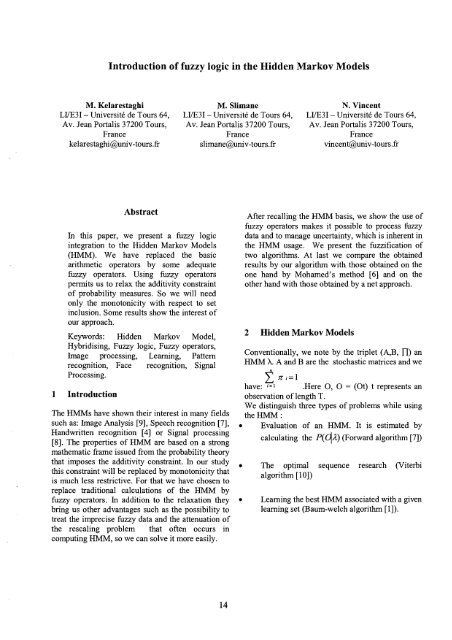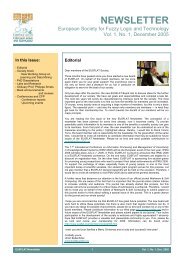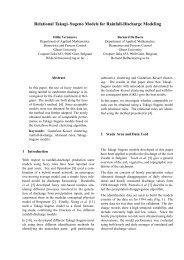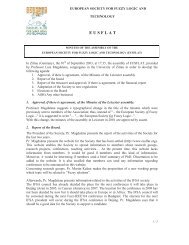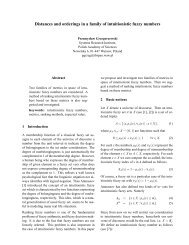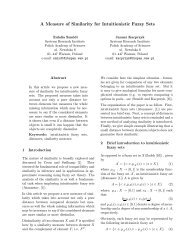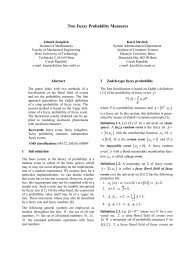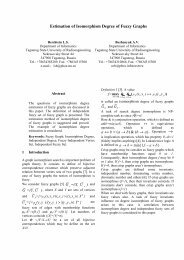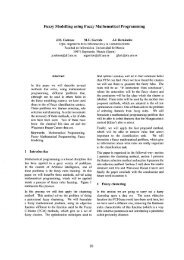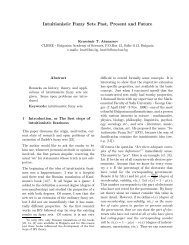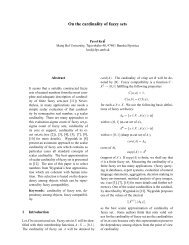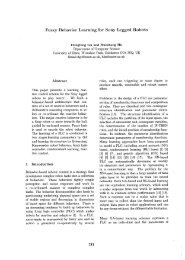Introduction of fuzzy logic in the Hidden Markov Models - EUSFLAT
Introduction of fuzzy logic in the Hidden Markov Models - EUSFLAT
Introduction of fuzzy logic in the Hidden Markov Models - EUSFLAT
You also want an ePaper? Increase the reach of your titles
YUMPU automatically turns print PDFs into web optimized ePapers that Google loves.
<strong>Introduction</strong> <strong>of</strong> <strong>fuzzy</strong> <strong>logic</strong> <strong>in</strong> <strong>the</strong> <strong>Hidden</strong> <strong>Markov</strong> <strong>Models</strong><br />
M. Kelarestaghi M. Slimane N. V<strong>in</strong>cent<br />
LYE31 - UniversitC de Tours 64, LYE31 - UniversitC de Tours 64, LYE31 - UniversitC de Tours 64,<br />
Av. Jean Portalis 37200 Tours, Av. Jean Portalis 37200 Tours, Av. Jean Portalis 37200 Tours,<br />
France France France<br />
kelarestaghi@univ-tours. fi slimane@univ-tours.fr v<strong>in</strong>cent@univ-tours.fr<br />
Abstract<br />
In this paper, we present a <strong>fuzzy</strong> <strong>logic</strong><br />
<strong>in</strong>tegration to <strong>the</strong> <strong>Hidden</strong> <strong>Markov</strong> <strong>Models</strong><br />
(HMM). We have replaced <strong>the</strong> basic<br />
arithmetic operators by some adequate<br />
kzy operators. Us<strong>in</strong>g <strong>fuzzy</strong> operators<br />
permits us to relax <strong>the</strong> additivity constra<strong>in</strong>t<br />
<strong>of</strong> probability measures. So we will need<br />
only <strong>the</strong> monotonicity with respect to set<br />
<strong>in</strong>clusion. Some results show <strong>the</strong> <strong>in</strong>terest <strong>of</strong><br />
our approach.<br />
Keywords: <strong>Hidden</strong> <strong>Markov</strong> Model,<br />
Hybridis<strong>in</strong>g, Fuzzy <strong>logic</strong>, Fuzzy operators,<br />
Image process<strong>in</strong>g, Learn<strong>in</strong>g, Pattern<br />
recognition, Face recognition, Signal<br />
Process<strong>in</strong>g.<br />
1 <strong>Introduction</strong><br />
The HMMs have shown <strong>the</strong>ir <strong>in</strong>terest <strong>in</strong> many fields<br />
such as: Image Analysis [9], Speech recognition [7],<br />
Handwritten recognition [4] or Signal process<strong>in</strong>g<br />
[8]. The properties <strong>of</strong> HNIM are based on a strong<br />
ma<strong>the</strong>matic frame issued from <strong>the</strong> probability <strong>the</strong>ory<br />
that imposes <strong>the</strong> additivity constra<strong>in</strong>t. In our study<br />
this constra<strong>in</strong>t will be replaced by monotonicity that<br />
is much less restrictive. For that we have chosen to<br />
replace traditional calculations <strong>of</strong> <strong>the</strong> HMM by<br />
<strong>fuzzy</strong> operators. In addition to <strong>the</strong> relaxation <strong>the</strong>y<br />
br<strong>in</strong>g us o<strong>the</strong>r advantages such as <strong>the</strong> possibility to<br />
treat <strong>the</strong> imprecise <strong>fuzzy</strong> data and <strong>the</strong> attenuation <strong>of</strong><br />
<strong>the</strong> rescal<strong>in</strong>g problem that <strong>of</strong>ten occurs <strong>in</strong><br />
comput<strong>in</strong>g HMM, so we can solve it more easily.<br />
After recall<strong>in</strong>g <strong>the</strong> HMM basis, we show <strong>the</strong> use <strong>of</strong><br />
<strong>fuzzy</strong> operators makes it possible to process <strong>fuzzy</strong><br />
data and to manage uncerta<strong>in</strong>ty, which is <strong>in</strong>herent <strong>in</strong><br />
<strong>the</strong> HMM usage. We present <strong>the</strong> fuzzification <strong>of</strong><br />
two algorithms. At last we compare <strong>the</strong> obta<strong>in</strong>ed<br />
results by our algorithm with those obta<strong>in</strong>ed on <strong>the</strong><br />
one hand by Mohamed7s method [6] and on <strong>the</strong><br />
o<strong>the</strong>r hand with those obta<strong>in</strong>ed by a net approach.<br />
2 <strong>Hidden</strong> <strong>Markov</strong> <strong>Models</strong><br />
Conventionally, we note by <strong>the</strong> triplet (A,B, n) an<br />
HMM X A and B are <strong>the</strong> stochastic matrices and we<br />
2 ni=l<br />
have: '=I .Here 0, 0 = (Ot) t represents an<br />
observation <strong>of</strong> length T.<br />
We dist<strong>in</strong>guish three types <strong>of</strong> problems while us<strong>in</strong>g<br />
<strong>the</strong> HMM :<br />
Evaluation <strong>of</strong> an HMM. It is estimated by<br />
calculat<strong>in</strong>g <strong>the</strong> P(@) (Forward algorithm [7])<br />
The optimal sequence research (Viterbi<br />
algorithm [lo])<br />
Learn<strong>in</strong>g <strong>the</strong> best HMM associated with a given<br />
learn<strong>in</strong>g set (Baum-welch algorithm [I]).
For example <strong>the</strong> three steps <strong>of</strong> <strong>the</strong> Forward<br />
algorithm can be stated by :<br />
1. Initialisation<br />
2. Induction<br />
at+l(j ) =Ci=1 ton (at(i ) * aij)<br />
*bj(Ot+J 'dt~ 1..T-1 ,'dj E l..n (1)<br />
3. Term<strong>in</strong>ation :<br />
P( 011 ) 6 Ci=l ton a~ ( i )<br />
In fact <strong>the</strong> method that we develop here has been<br />
generalized also to <strong>the</strong> o<strong>the</strong>r algorithms <strong>of</strong> HMM <strong>in</strong><br />
order to obta<strong>in</strong> <strong>the</strong> results presented <strong>in</strong> <strong>the</strong> last<br />
section.<br />
3 Fuzzy Approach<br />
3.1 Fuzzy Operators<br />
The <strong>fuzzy</strong> subset <strong>the</strong>ory was presented by Zadeh<br />
[l 11 to treat imprecise and uncerta<strong>in</strong> data. It def<strong>in</strong>es<br />
<strong>the</strong> membership function with respect to <strong>the</strong> <strong>fuzzy</strong><br />
subsets to measure <strong>the</strong> likeness between <strong>the</strong> data and<br />
<strong>the</strong>se subsets. The <strong>fuzzy</strong> data are treated by means <strong>of</strong><br />
<strong>fuzzy</strong> operators. These operators are <strong>the</strong> basis <strong>of</strong> <strong>the</strong><br />
generalisation <strong>of</strong> <strong>the</strong> <strong>fuzzy</strong> <strong>logic</strong> <strong>in</strong> different doma<strong>in</strong>s<br />
such as control [5], approximate reason<strong>in</strong>g [2], data<br />
fusion [3]. Generally we can design a <strong>fuzzy</strong> system,<br />
based on a non-<strong>fuzzy</strong> one by generalis<strong>in</strong>g <strong>the</strong><br />
calculus to <strong>the</strong> <strong>fuzzy</strong> data or also, based on a<br />
completely <strong>fuzzy</strong> way <strong>of</strong> reason<strong>in</strong>g. In <strong>the</strong> next<br />
paragraph we present <strong>the</strong> generalisation <strong>of</strong> a HMM<br />
to <strong>the</strong> <strong>fuzzy</strong> case.<br />
3.2 Application to <strong>the</strong> Forward algorithm<br />
A <strong>fuzzy</strong> modell<strong>in</strong>g can be <strong>in</strong>troduced at different<br />
levels, particularly at <strong>the</strong> data level, at reason<strong>in</strong>g<br />
mode level or directly us<strong>in</strong>g a <strong>fuzzy</strong> <strong>Markov</strong> model<br />
itself whose elements would be <strong>fuzzy</strong>. For <strong>the</strong> data<br />
level <strong>in</strong>tegration, it is possible to apply <strong>the</strong> classical<br />
extension pr<strong>in</strong>ciples <strong>of</strong> <strong>the</strong> net functions to <strong>fuzzy</strong><br />
sets. We didn't choose this solution. It seems wiser<br />
to search a <strong>fuzzy</strong> version <strong>of</strong> <strong>the</strong> <strong>Hidden</strong> <strong>Markov</strong><br />
<strong>Models</strong> (fHMM) and to use <strong>the</strong> <strong>fuzzy</strong> operators that<br />
lead to <strong>the</strong> possibility to use all k<strong>in</strong>ds <strong>of</strong> data. So <strong>the</strong><br />
elements <strong>of</strong> <strong>the</strong> matrices A, B, n are considered as<br />
<strong>the</strong> <strong>fuzzy</strong> subsets. We limit ourselves to <strong>the</strong> subsets<br />
with triangular belong<strong>in</strong>g functions, <strong>in</strong> fact, <strong>the</strong>ir<br />
base width can be seen as an uncerta<strong>in</strong>ty measure.<br />
We have transformed <strong>the</strong> classical formulas used <strong>in</strong><br />
<strong>the</strong> different algorithms, and for example <strong>the</strong><br />
formula (1) becomes formula (2):<br />
at+]( j ) =MIN {MAX { MIN {at( i ), aij >><br />
, bj (O,,)) 'dt E l..T-1 , 'dj E l..n (2)<br />
The MIN and <strong>the</strong> MAX operators are not <strong>the</strong> usual<br />
ones. They do not even are extensions <strong>of</strong> <strong>the</strong><br />
classical ones. They are def<strong>in</strong>ed on <strong>fuzzy</strong> sets as<br />
follow<strong>in</strong>g. If two <strong>fuzzy</strong> subsets have any overlap we<br />
will use <strong>the</strong> normal operators, but for <strong>the</strong> subsets<br />
without overlapp<strong>in</strong>g parts <strong>the</strong> normal operators will<br />
always give <strong>the</strong> results equal to zero. To be able to<br />
afford this problem we will use <strong>the</strong> mean <strong>of</strong> <strong>the</strong> two<br />
subsets. In one hand we solve our problem and on<br />
<strong>the</strong> o<strong>the</strong>r hand we could avoid <strong>the</strong> rescal<strong>in</strong>g problem<br />
specially for <strong>the</strong> MIN operator.<br />
The MIN and MAX operators are def<strong>in</strong>ed <strong>in</strong> such a<br />
way that, <strong>in</strong> each calculus step, we f<strong>in</strong>d a triangular<br />
subset to model a . It is a very important po<strong>in</strong>t s<strong>in</strong>ce<br />
it permits us to avoid <strong>the</strong> rescal<strong>in</strong>g phase. In fact <strong>the</strong><br />
<strong>fuzzy</strong> <strong>in</strong>formation is <strong>in</strong>dicated <strong>in</strong> a function <strong>the</strong><br />
support <strong>of</strong> which does not become too wide. O<strong>the</strong>r<br />
aggregation or MEAN operators have been tried <strong>in</strong><br />
place <strong>of</strong> product. All figures must be centered like<br />
Figure 1. The number and caption <strong>of</strong> <strong>the</strong> figure must<br />
always appear below <strong>the</strong> figure.<br />
4 Results<br />
Experiments were performed on a face image data<br />
base(400 images). We have compared <strong>the</strong> results <strong>of</strong><br />
HMM algorithm and fHMM algorithm with also <strong>the</strong><br />
results obta<strong>in</strong>ed from Mohamed's [5] algorithm. Our<br />
image data base conta<strong>in</strong>s <strong>the</strong> images <strong>of</strong> 100 persons<br />
each one <strong>in</strong> 4 different positions. For each person a<br />
learn<strong>in</strong>g is performed by us<strong>in</strong>g three positions and<br />
we want to recognize this person <strong>in</strong> his fourth image.<br />
The obta<strong>in</strong>ed results show a good performance for<br />
fHMM specially for <strong>the</strong> cases <strong>in</strong> which <strong>the</strong> noise<br />
level <strong>of</strong> <strong>the</strong> image to be recognized is important.<br />
Figure 1 gives a brief comparison between three<br />
methods: firstly <strong>the</strong> learn<strong>in</strong>g us<strong>in</strong>g <strong>the</strong> Mohamed and<br />
Gader method and secondly <strong>the</strong> classical method<br />
us<strong>in</strong>g <strong>the</strong> normal HMM and thirdly our method<br />
us<strong>in</strong>g <strong>the</strong> fuzzified HMM (fHMM).
100<br />
additive noise<br />
1 2 3 4 5 6 7<br />
Noise level<br />
Figure 1 : comparative results.<br />
In this figure we study <strong>the</strong> recognition rate <strong>of</strong><br />
different methods for <strong>the</strong> noisy signals. We observe<br />
that for all <strong>the</strong> methods <strong>the</strong> recognition rate<br />
decreases when we <strong>in</strong>crease <strong>the</strong> <strong>in</strong>jected noise <strong>in</strong><br />
signal. But at <strong>the</strong> same time we observe a good<br />
behavior <strong>of</strong> our method, for <strong>the</strong> signals with a big<br />
noise <strong>in</strong>jection degree.<br />
5 Conclusion and perspectives<br />
We have presented <strong>the</strong> <strong>in</strong>tegration <strong>of</strong> <strong>fuzzy</strong> <strong>logic</strong> to<br />
<strong>the</strong> <strong>Hidden</strong> <strong>Markov</strong> <strong>Models</strong>. This <strong>in</strong>tegration<br />
consists <strong>in</strong> replac<strong>in</strong>g <strong>the</strong> basic arithmetic operations<br />
by <strong>the</strong> adequate <strong>fuzzy</strong> operators. Us<strong>in</strong>g <strong>the</strong> <strong>fuzzy</strong><br />
operators permits us <strong>in</strong> one hand to manage <strong>the</strong><br />
imprecision concern<strong>in</strong>g <strong>the</strong> data, and <strong>in</strong> <strong>the</strong> o<strong>the</strong>r<br />
hand it relaxes <strong>the</strong> additivity constra<strong>in</strong>t, necessary<br />
for <strong>the</strong> HMM, towards <strong>the</strong> monotonicity one, much<br />
less restrictive. The new algorithms could be applied<br />
directly on <strong>fuzzy</strong> data. The performed tests for noisy<br />
images recognition, showed encourag<strong>in</strong>g results<br />
particularly for <strong>the</strong> cases with an important noise.<br />
After us it should be <strong>in</strong>terest<strong>in</strong>g to try to model <strong>the</strong><br />
HMM by <strong>the</strong> hzzy rules and so we could translate<br />
<strong>the</strong> HMM to a more adequate fHMM.<br />
References<br />
[I] L. E. Baum, J. A. Eagon, (1967)"An <strong>in</strong>equality<br />
with application to statistical estimation for<br />
probabilistic functions <strong>of</strong> <strong>Markov</strong> processes and<br />
to a model <strong>of</strong> ecology", Bull American Society,<br />
Vol, 73, pp. 360-363, 1967.<br />
[2] D. Dubois, H. Prade, (1991)" Fuzzy sets <strong>in</strong><br />
approximate reason<strong>in</strong>g Part 1 : Inference with<br />
possibility distributions," Fuzzy Sets and<br />
Systems 40, 143-202, 199 1.<br />
[3] C. Dujet, N. V<strong>in</strong>cent, (1998)(( Data fusion<br />
Modell<strong>in</strong>g human behaviour,)) International<br />
Journal <strong>of</strong> <strong>in</strong>telligent systems, vol. 13, 27-39,<br />
1998.<br />
[4] M. Gilloux, (1997)"Real-time handwritten word<br />
recognition with<strong>in</strong> large lexicon", <strong>in</strong> Progress <strong>in</strong><br />
Handwrit<strong>in</strong>g Recognition, A.C. Downton and S.<br />
Impedovo Eds, World Scientific, pp. 45-50,<br />
1997.<br />
[5] E. H. Mamdani, S. Assilian,(l975) "An<br />
experiment <strong>in</strong> l<strong>in</strong>guistic syn<strong>the</strong>sis with a <strong>fuzzy</strong><br />
<strong>logic</strong> controller," International Journal <strong>of</strong> Man-<br />
Mach<strong>in</strong>e studies 7, 1-1 3, 1975.<br />
[6] M. A. Mohamed, P. Gader, (2000)"Generalized<br />
hidden markov models-part I: Theoretical<br />
frameworks," IEEE Transaction on <strong>fuzzy</strong><br />
systems, Vol. 8, No. 1, pp. 67-81,2000.<br />
[7] L. R. Rab<strong>in</strong>er, (1989)"A tutorial on hidden<br />
<strong>Markov</strong> models and selected application <strong>in</strong><br />
speech recognition", Pro. <strong>of</strong> IEEE, vo77, p.<br />
257-286,1989.<br />
[8] M, Saerens, "<strong>Hidden</strong> <strong>Markov</strong> models assum<strong>in</strong>g<br />
a cont<strong>in</strong>uous time dynamic emission <strong>of</strong> acoustic<br />
vectors", Proceed<strong>in</strong>gs <strong>of</strong> Eurospeech ,1993.<br />
[9] M. Slimane, G. Ventur<strong>in</strong>i, J.-P. Assel<strong>in</strong> De<br />
Beauville, T. Brouard, A. Brandeau,<br />
(1 996)((0ptimiz<strong>in</strong>g HMM with a genetic<br />
algorithm,)), Artificial Evolution, Lecture notes<br />
<strong>in</strong> computer science, Spr<strong>in</strong>ger Verlag, Vol.<br />
1063, pp ; 384-396, 1996.<br />
[lo] A. J. Viterbi, (1967)"Error bounds for<br />
convolutional codes and asymptotically<br />
optimum encod<strong>in</strong>g algorithms", IEEE<br />
Transactions on <strong>in</strong>formation Theory, Vol ; 13,<br />
pp. 260-269, 1967.<br />
[ll] L. A. Zadeh, (1965)"Fuzzy sets," Information<br />
and Control 8,338-353, 1965.


